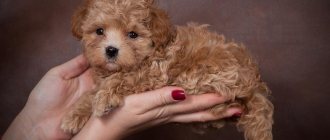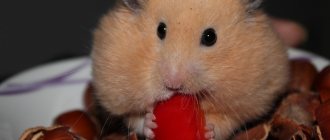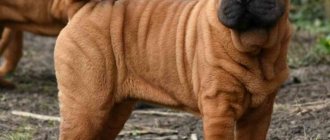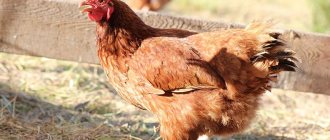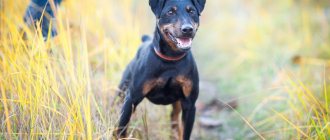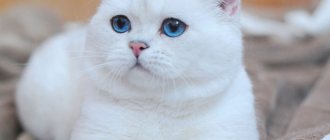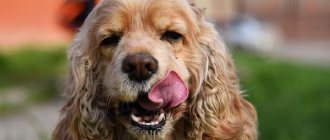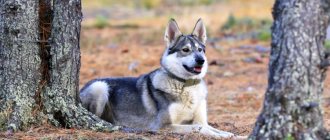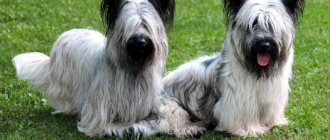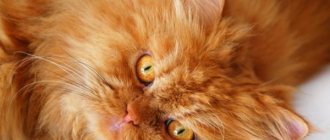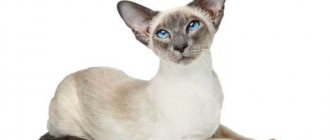| Origin: | Switzerland |
| Usage: | guard and draft dog, companion |
| Color: | tricolor |
| Dimensions: | 60 – 72 cm, 59 – 61 kg |
| Lifespan: | 8 – 10 years |
The Greater Swiss Mountain Dog is the largest of all the Mountain Dogs. In addition to it, there are 3 more subspecies of the breed: the Bernese with long hair, the small Entlebucher with a height of up to 50 cm and the short-haired Appenzeller with a curled tail.
Appearance and standard
The Greater Swiss Mountain Dog combines strength and grace. This is a smooth-haired large dog with an easy gait and balanced movements. The dog is representative, powerful, calm and charismatic.
| Breed characteristics | FCI breed standard dated 03/25/2003 |
| Height | Males 65-72 cm, females 60-68 cm. |
| Weight | Not clearly regulated by the standard, approximately 45 – 60 kg. |
| Constitution | Strong, rough-heavy. |
| Frame | Slightly longer than the height at the withers. The back is strong, straight with steep withers and sloping croup. The chest is voluminous, reaching to the elbows. The abdomen is moderately retracted. |
| Head | Large, but not massive, harmonious. |
| Muzzle | Longer than wide. The forehead is flat. |
| Nose | Black. |
| Lips | Dry, dense, black pigmentation. |
| Ears | Triangular in shape and medium in size. They stand high. When at rest, they lie close to the cheekbones; when excited, they rise and turn forward. |
| Eyes | Round, almond-shaped, moderately set, with a black rim. All shades of brown are allowed - from light walnut to dark chestnut. |
| Bite | Scissor-shaped. |
| Tail | Logically continues the line of the back, reaching the knees. At rest it is lowered down, when moving it rises up, but does not fall back onto the croup. |
| Limbs | Straight, with well-developed muscles, they stand wide. |
| Paws | Round, in a lump. The fifth toes are docked. |
| Wool | Close to the body, medium length, thick with developed undercoat. The latter is painted gray or black. |
| Color | Tricolor. The main color is anthracite black. There are brownish-red markings on the cheeks, brow ridges, inside the ears, on both sides of the chest, on the limbs and under the tail. White spots are located on the forehead and muzzle, throat, chest, paws and tip of the tail. |
Story
There are many ambiguities and “blank spots” in the history of the Sennenhunds. What is known for certain is that this is a very ancient breed. In everything else, regarding the origin, the opinions of experts differ. Some dog handlers consider these strong and majestic animals to be the descendants of the fighting dogs of the Roman legionnaires who conquered the territories of modern Switzerland and France. Other dog experts believe that the ancestor of the Mountain Dog was the Tibetan Mastiff, considered the ancestor of all Great Dane breeds.
The fighting dogs that came to the territory of Switzerland and France quickly changed their original purpose. After all, the people living in these areas were not engaged in battles, but in peaceful labor, and they had a need to breed a strong, powerful dog that would help herd and protect livestock from wolves and other predators, and at the same time protect the house from robbers and deserters, who there were plenty of those troubled times.
In the old days, there was no division of Sennenhunds into breed varieties. In one litter, both large and medium-sized puppies were born with different types and lengths of fur, and sometimes with different colors, although already in ancient times the predominant color was black-white-red tricolor.
As for the Pyrenean mountain dog, despite its common origin with all Sennenhunds, from the very beginning it differed in color from other breeds similar to it. And its history is also noticeably different.
Unlike the Swiss breeds, the Pyrenees were lucky enough to fall into favor with the French kings and become court dogs. It so happened that one day Louis XIV, known as the Sun King, while touring his possessions, drew attention to the huge and majestic white dogs that lived only in the Pyrenees. The king immediately fell in love with these giants and wanted to take the aboriginal dogs into the palace. Intelligent and intelligent Pyrenean mountain dogs were declared by him to be a court breed, and puppies born from royal favorites and presented to them by a courtier were considered the highest sign of royal favor and favor.
True, during the French Revolution, the court “Pyrenees” had a hard time, but due to the fact that the breed was originally a working breed, it managed to survive and subsequently regain its former popularity.
And other Sennenhunds, which experts finally paid attention to at the beginning of the 20th century, also became popular, not only as working dogs, but also as show dogs. Their beauty, majestic strength and power allowed these dogs to win the love of millions of people, and their wonderful affectionate and obedient character made them suitable for working as guide dogs, as well as animals suitable for canine therapy.
They are also used as search dogs, as well as rescue dogs used in eliminating the consequences of natural disasters such as rock falls, earthquakes, landslides, avalanches, etc.
Mountain dogs received official recognition already in the 20th century, and around the same time, the division of one original breed into varieties began, differing from each other both in size and in some exterior features. Currently, all Sennenhunds are officially recognized dog breeds, each of which has its own standard.
For those who are interested in how the word “Sennenhund” is translated: it is composed of 2 parts - Hund (German der Hund) dog and Zenen (German der Senne) alpine shepherd or meadow.
Features of behavior and character
The Greater Swiss Cattle Dog has the most complex character of all the Mountain Dogs.
The description of the breed speaks of the Grosser as a serious dog. He is calm, balanced, cautious, and does not tolerate familiarity. At the same time, he loves family and builds special relationships with each family member. Separately highlights the owner.
The pet is loving towards family members and friends. But he treats strangers with restraint and caution. Until the dog understands that the stranger is a friend, it will not leave its owner.
The Great Mountain Dog is reasonable, but not phlegmatic. He is energetic, loves to play with people and relatives, and fool around with children.
You need to find an approach to large Swiss Mountain Dogs. Dogs are not inclined to dominate, but they show character, especially in adolescence. If the owner does not establish the correct hierarchical relationships, the pet will take the position of leader.
Greater Swiss Mountain Dogs are quiet people. They bark only for a reason.
Grosser can express love by jumping on his chest or climbing into his arms. If the owner likes this cute trait, he should teach the pet to cuddle on command. Otherwise, a 60-kilogram dog will rest on the chest of a three-year-old child or knock down a fragile woman.
Origin of the breed
Experts who know a lot about dogs love BSHZ for its easy-going nature, reliability and nobility of character. Many consider the mountain dog to be one of those breeds whose working qualities exceed their visual attractiveness. However, it is worth admitting that the appearance of Gross dogs, their original color and convincing muscles are admirable.
There are different versions regarding the origin of the breed:
- The first says that the BSHZ are direct descendants of the Molossians, who were brought to Switzerland by Roman legionnaires. Warriors traditionally took powerful dogs on campaigns, which were assigned real combat tasks. In their free time, the dogs probably interacted actively with local herding dogs. The result of such a relationship could well be offspring with the breed characteristics of the current Swiss Mountain Dogs.
- According to another version, it is more correct to consider the Balkans and Apennines as the homeland of the Gross, where the ancestors of these dogs guarded fat herds of cows and sheep. It is precisely this origin that explains the character of the BSHZ, which reveals the dog not as a warrior, but as a shepherd.
Translated from Bavarian, "Sennenhund" means "alpine meadow dog"
The name of the breed contains the word “Sennenhund”, the origin of which is unclear to many. Meanwhile:
- translated from Bavarian it means “dog from the Alpine meadows”;
- in Swiss dialect it translates to “a shepherd whose cattle graze in the Alps and provide milk for curds and cheese.” If we shorten the concept somewhat and apply it to an animal, it turns out that the “Sennenhund” is nothing more than a “cheese and curd dog” or an animal that lives in the region where cheese and cottage cheese are made.
Cute and tasty name, right? However, it does not reflect all the abilities of the smart and strong Alpine dog, which in former times not only guarded livestock, but also:
- transported heavy loads while working as a draft animal;
- helped butchers and gardeners, shopkeepers and bakers in their hard work.
Sennenhunds are kind and loyal companions.
Today, the Gross is more valued for its protective qualities, as well as for its ability to be a kind and devoted companion.
Application
Previously, Grosses were used as herding and draft dogs. Today they are the best companions and favorites of the whole family.
However, the Great Swiss Mountain Dog has not lost its working traits. She happily carries bags in her mouth, rides children on sleds and pulls carts. While walking he tries to knock him down.
If necessary, large Swiss Mountain Dogs can be trained for guard duty and even security services. However, they take a long time to learn skills, plus the pets are kind, they lack vigilance and aggression.
It is better not to eradicate the natural kindness of Sennenhunds. If you need a guard and protector, they prefer an Alabai or a German Shepherd.
Among sports cultures, agility and canicross are suitable for gross. The dog happily follows commands and takes on barriers.
Three interesting facts
- They fiercely and relentlessly protect the weak half of humanity . If the breeder turns out to be a woman, then men should be more careful when approaching a lady with such a dog on the street. Since ancient times, the Grosses have protected the family and especially its weaker members, women and children. This habit became firmly established and became a character trait.
- Can't stand perfume . Very often this breed is allergic to strong odors.
- They feel calm in harness . They can be harnessed together with ponies, for example. And all because for a long time grosses were used as draft animals.
Socialization
Grosser will be a good nanny for children. He is aware of his size and strength, so in the presence of children he moves carefully, trying not to touch or hit the child.
However, the Greater Swiss Mountain Dog should not be left alone with preschoolers. No matter how careful your pet is, she may inadvertently crush or push the baby.
Natural kindness makes the Greater Swiss Mountain Dog a wonderful family member. He is affectionate with children and gets along well with other pets. Aggression between male dogs is possible, but this is more a flaw in upbringing than an innate trait.
The Grosser treats cats, rodents and birds not from the “flock” without warmth. He can chase or even kill your pet.
Who is better: Bernese or Grosser?
Although Berns and Gross are essentially brothers, there are significant differences between them:
- The difference is in temperament and character: from the experience of breeders, we can say that Bernese Mountain Dogs are more phlegmatic, while Gross Dogs are sanguine, they are emotional and lively, but not malicious.
- They also show their love in different ways : Berns are restrained in their feelings, calm, reasonable and serious, while Grosses are sincere and emotionally responsive;
- Heat resistance . Long-haired Bernese dogs suffer from the heat in the apartment in the summer, while smooth-haired dogs are comfortable at any time of the year;
Whom to choose is up to the breeder. Any pet will require time, effort and financial investment. It is important to understand that the acquisition of a living creature is permanent, not temporary, and when the first difficulties arise, you should not throw it out into the street.
Upbringing
The Greater Swiss Mountain Dog breed needs training. At least in OKD. Moreover, the sooner the dog learns the commands, the better.
The fact is that Swiss Mountain Dog puppies grow quickly. Already at six months they weigh 30 - 40 kg, and at one year - all 60 kg. At the same time, they mature psychologically slowly - only by the age of 2-2.5 years are dogs considered adults.
If you don’t raise a Mountain Dog, it’s impossible to cope with fifty unmanageable kilograms. Therefore, the rules and basics of good behavior are instilled in children as soon as they cross the threshold of a new home.
Puppies take a long time to learn hygiene standards. Puddles and piles will appear around the house for up to six months.
When training, you need a firm hand, consistency and endless encouragement. They take into account that Greater Swiss Mountain Dogs respond better to affection and praise than to treats. But the goodies are not superfluous.
You cannot shout, pull back, pull on the leash, or even spank the dog. The big mountain dog will not tolerate this. He will be offended, withdrawn and refuse to follow commands. And it’s good if it’s just for a couple of days, and not forever.
Greater Swiss Mountain Dogs are not the best students. They remember orders for a long time, are stubborn and self-willed. But once they learn a command, the pets will always follow it.
Training
The Sennenhund is an easy-to-train dog. They are smart and understand what the owner wants, and try to please him. They cope best with tasks of a monotonous nature, such as transporting goods.
Success in training a Swiss Shepherd depends on the owner's ability to control it, as the pet needs a confident hand. The dog must learn that the owner is the leader. Then she will obey him unquestioningly. Given the submissive nature of Mountain Dogs, even an inexperienced dog owner can control them without much effort. The main thing is not to leave your pet’s upbringing unattended. No shouting or force is needed when training these dogs. They do not try to dominate the family, and will not fight back if they are raised correctly.
Sennenhunds should receive both physical and mental exercise regularly.
Features of maintenance and care
Swiss Mountain Dogs are easy to keep. A private home with a spacious backyard would be best for them. However, pets cannot be placed in an enclosure or on a chain. These are companions, they need to constantly communicate with family members and participate in household chores.
If you exercise the large Swiss Mountain Dogs enough, you can have them in spacious apartments. It is important that dogs spend all their energy on walks and relax at home. Otherwise, the cozy nest will turn into ruins.
Grooming
The short-haired Swiss Mountain Dog will not cause any trouble. Caring for it is standard and does not take much time and effort:
- comb the pet once a week, during the molting period in spring and autumn - once every 2-3 days;
- for combing you need a hard slicker brush, a brush with soft and long bristles and a furminator;
- the eyes are wiped with antiseptic solutions as they sour;
- ears are cleaned with sponges soaked in veterinary cleaner, cotton swabs are not used - there are a lot of hairs inside the auricle that can be pushed deep into the ear canal;
- the claws are trimmed as they grow with a sickle-shaped claw clipper;
- teeth are brushed once a week;
- To remove plaque, they provide cartilage, large bones - moslaks, industrial toothpicks.
In general, the Grosser is unpretentious. He does not need haircuts, his fur hardly gets dirty and does not get tangled. It is worth considering that Greater Swiss Mountain Dogs shed heavily. Therefore, they buy a more powerful vacuum cleaner or move the pets into a separate room while they change their fur coat.
Bathing
The Greater Swiss Mountain Dog is a clean dog. She will walk around a puddle of mud with disgust and will not dig through the trash.
Dogs are washed rarely - once every 1-3 months. If the Mountain Dogs are show dogs, they are bathed before each competition.
Greater Swiss Mountain Dogs love to swim. They happily splash in the bathtub and swim in ponds.
Walk
Walk the Greater Swiss Mountain Dog in the morning and evening for 1-1.5 hours. Quiet walks on a leash are not suitable for pets. Games, jogging and activities are needed.
If dogs do not release their energy every day, they will become nervous, aggressive, and develop behavioral problems.
Up to 2-4 times a month, outings into nature are desirable. Large Swiss Mountain Dogs love hiking in forests, forests, mountains, and trips to lakes and rivers.
The Grosser is adapted to cool climates and easily overheats. He is hot even in spring and autumn. In summer, the pet is taken out in the morning and evening, when it is not hot.
There is no need to dress the dogs - they don’t freeze. But in slush they use a water-repellent blanket to prevent the wool from getting dirty.
Nutrition
It is better to feed Greater Swiss Mountain Dogs with industrial holistic food or super-premium food with low fat content. It is difficult to balance your diet on a natural diet.
Ready-made foods suitable for puppies include:
- Orijen Puppy Large Grain Free;
- Applaws Puppy Large Breed Chicken Grain Free;
- Acana Heritage Puppy Large Breed Grain Free.
Swiss adults buy:
- Applaws Adult Large Breed Chicken Grain Free
- Grandorf Adult Maxi Lamb & Rice
- Acana Heritage Adult Large Breed Grain-Free
If the choice falls on nature, take into account that:
- you cannot feed or treat the Greater Swiss Mountain Dog from the table - they cook for him separately;
- Animal proteins in the daily menu should be at least 50%, ideally 70%;
- the diet consists of lean meats, fermented milk products, ocean fish, offal, cereals, vegetables, fruits;
- Give eggs, brown algae, fish oil 1-2 times a week;
- every day they must include calcium, magnesium, phosphorus, vitamins C, E, group B, chondoprotectors and probiotics for the normal development of the skeleton, joints and the functioning of internal organs;
- Food allergies are possible, so new foods are introduced carefully.
Swiss Mountain Dogs are prone to bloating and volvulus in the stomach and intestines. Therefore, games and walks are prohibited for 1-2 hours after feeding. It is advisable to take your pets outside before eating.
Health
Grosser cannot boast of longevity or a strong body. The breed suffers from hereditary and acquired diseases. And the average life expectancy is 8-10 years.
How long a pet will live depends on genes, quality of feeding and care. Owners whose Greater Swiss Mountain Dogs celebrated their 12th or 13th birthday are considered lucky.
Diseases
Greater Swiss Mountain Dogs are susceptible to:
- cancer;
- eye diseases (entropy, cataracts, atrophy);
- epilepsy;
- skeletal problems: osteochondrosis, dysplasia of the elbow and hip joints;
- enuresis - females are more likely to suffer.
To prevent dysplasia, avoid excessive stress, carrying heavy objects, and jumping from heights. Puppies up to 4-6 months of age are held in arms when going up and down stairs.
Vaccinations
Vaccination is required. Greater Swiss Mountain Dogs are vaccinated against:
- plague, trichophytosis, enteritis, hepatitis, leptospirosis, coronavirus - at 8 weeks followed by vaccination at 12 weeks;
- rabies – at 6 months;
- at 12 months and then annually receive a comprehensive vaccination against possible infections.
The exact vaccination schedule and list of vaccines are compiled by a veterinarian for each dog separately, taking into account the individual characteristics of the pet and the epidemiological situation in the area.
Possible diseases
Unfortunately, the “Swiss” has a short life expectancy (about 10-11 years) and is prone to the following diseases:
— An allergy is a painful reaction of the body to an allergen.
— Dysplasia is a disease of cartilage tissue that causes deformation of joints or disruption of their integrity. It usually has a hereditary origin - when purchasing a puppy, you should ask for a medical certificate about the health of its parents.
- Osteochondrosis - various destructions of cartilage tissue due to various dystrophies. It usually affects the shoulder musculoskeletal system.
— Entropion is the turn of the century. Deformation of the eyelid line, due to which the eyelashes cause irritation of the mucous membrane and damage to the eyeball.
- Eye diseases - cataracts, retinal atrophy.
— Oncological diseases (are hereditary in nature).
Mating
Grosser takes a long time to mature. It reaches full maturity by 2-2.5 years. Although the first estrus in females occurs before the age of one year.
Estruses recur every 6-9 months. Pets are untied from the 3rd or 4th heat. The mating is carried out on the territory of the male dog, having previously introduced the pets.
Pregnancy lasts 56-72 days. The more puppies in the litter, the longer the dog carries them. Childbirth usually takes place without problems, bitches give birth from 1 to 8 pups.
How to choose a puppy
Greater Swiss Mountain Dog puppies are absolutely adorable. But not all of them are healthy and meet the breed standard.
In order not to buy a sick kitten with defects, first choose a nursery. Professional breeders value their reputation, so they:
- will calmly answer any, even stupid, questions;
- will show registration documents;
- will present pedigrees and veterinary passports of the producers;
- will demonstrate certificates of victories in competitions and documents allowing dogs for breeding.
It is better to choose a Greater Swiss Mountain Dog in person. At the meeting, the condition of the baby’s fur coat, eyes, ears, teeth and temperament are assessed. According to the photo, puppies are taken as a last resort - when they are imported from abroad.
Photo quiz
Determine which pictures show the following breeds (write your answers in the comments):
Guess whose puppies are in the photo:
Price of puppies
The Greater Swiss Mountain Dog is a rare breed. In addition, it is expensive to maintain, care and treat.
Even with the hands of puppies they give from 25,000 rubles. But the savings come at a cost. There is a high risk that the cheap kitten is sick, and in the future it will cost hundreds of thousands of rubles to treat it.
The best option is nurseries. In them, the Greater Swiss Mountain Dog is more expensive, but it is healthy and properly raised.
The price for pet-class puppies starts from 35,000 rubles, breeds are sold for 50-60 thousand rubles, and show class representatives are sold for 80-90 thousand rubles.
Nurseries
In Moscow, proven nurseries for Greater Swiss Mountain Dogs include:
- https://bern-gross.ru – member of the National Breed Club of Russia, opened in 1998;
- https://www.z-hund.ru – breeds Bernese, Greater and Entlebucher Mountain Dogs, advises and helps new owners in raising and treating pets.
In St. Petersburg, the breeding of Greater Swiss Mountain Dogs is carried out by the Alert Escort kennel - https://spb-sennen.ucoz.ru. In addition to selling puppies, the breeder helps in the treatment, raising and education of pets.
The Greater Swiss Mountain Dog will become a friend, nanny, guard, protector and house helper. But only in the hands of a loving, strict and fair owner. If you don’t develop natural qualities, the dog will grow up neurasthenic and lose the breed’s character traits.
Price
- Pet class babies will cost approximately 25-30 thousand rubles.
- A puppy of a higher class, “ breeding ”, will cost 35-45 thousand.
- show class exhibition puppies you will have to pay from 50 to 100 thousand rubles.
Today it is not so often possible to see the Greater Swiss Mountain Dog on the street. The rarity and impressiveness of representatives of this breed should not be the main reasons for purchasing a puppy. Such a pet will require a lot of time, patience and finances, so it is important to weigh your options.
